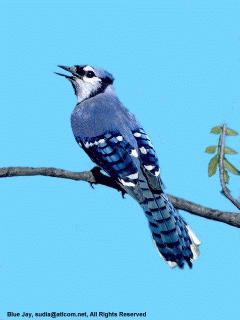

The blue jay is known for its mimicry. The blue jay has been known to imitate the screams of hawks.
The blue jay is nearly 1 foot (30 centimeters) long, including the tail. Its belly and chin are light gray. There is a collar of black feathers across its throat and on the sides of its head. The blue jaycan raise or lower the crest on its head. This crest is a fine shade of gray-blue with a purplish tint. The same color is in the feathers on the bird's back. The feathers on the blue jay's wings and tail are a brighter blue, with white bands and black crossbars.


Blue jays prefer to forage in the mixed woodlands containing many nut-bearing trees. These birds consume 3 times as much vegetable as animal matter. It is true theblue jay has been known to consume frogs, snails, and salamanders. It also eats many harmful insects.
During the nesting season, the blue jay takes the eggs and young from the nests of other birds. However, most of its food consists of nuts and smaller seeds. It also eats many harmful insects. Blue jays build loose, untidy nests in trees. Following mating, the pair defend their nest. The female lays 4 to 6 eggs which hatch in approximately 17 days. Fledglings are ready to leave the nest in an additional 17 to 21 days. The birds live about four years. Young blue jays make amusing pets.